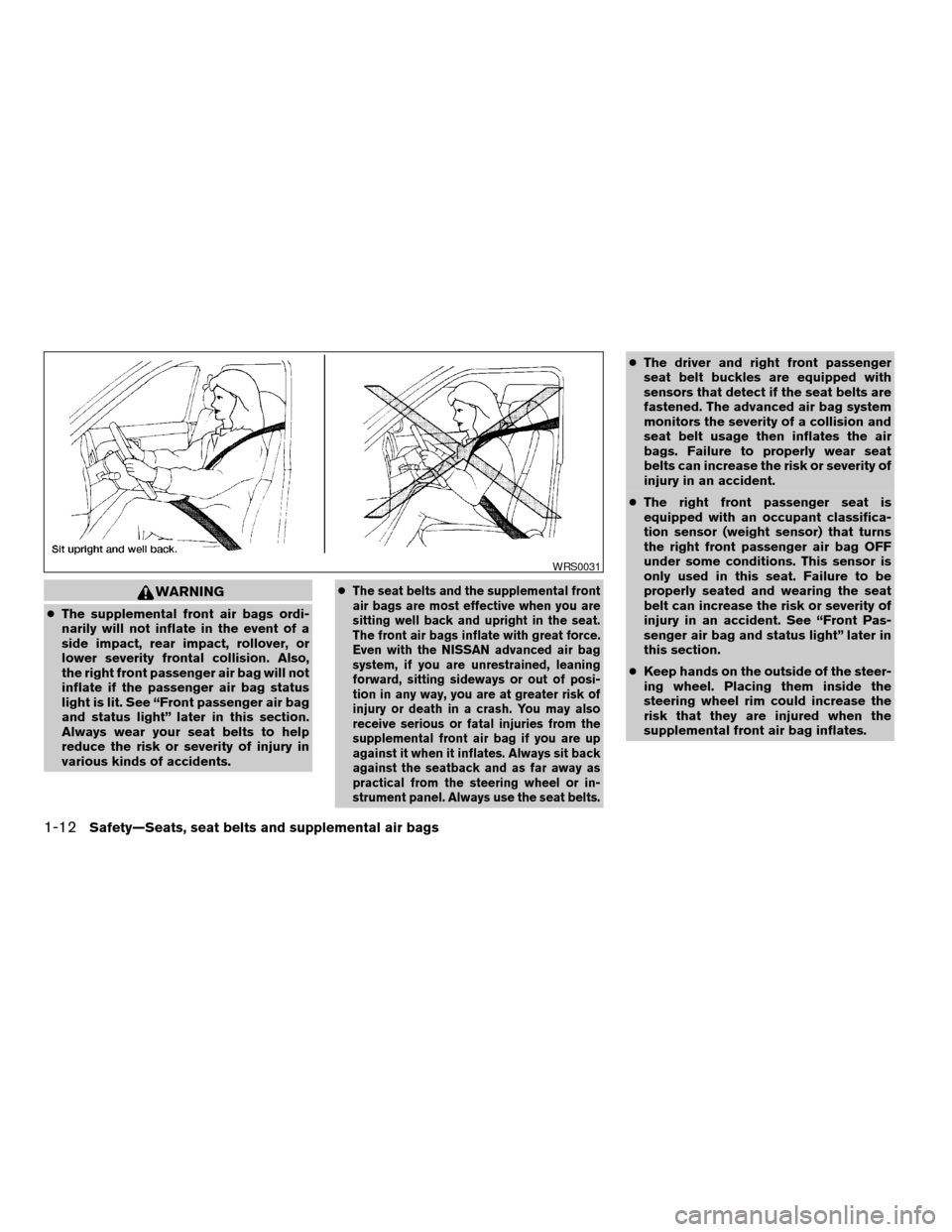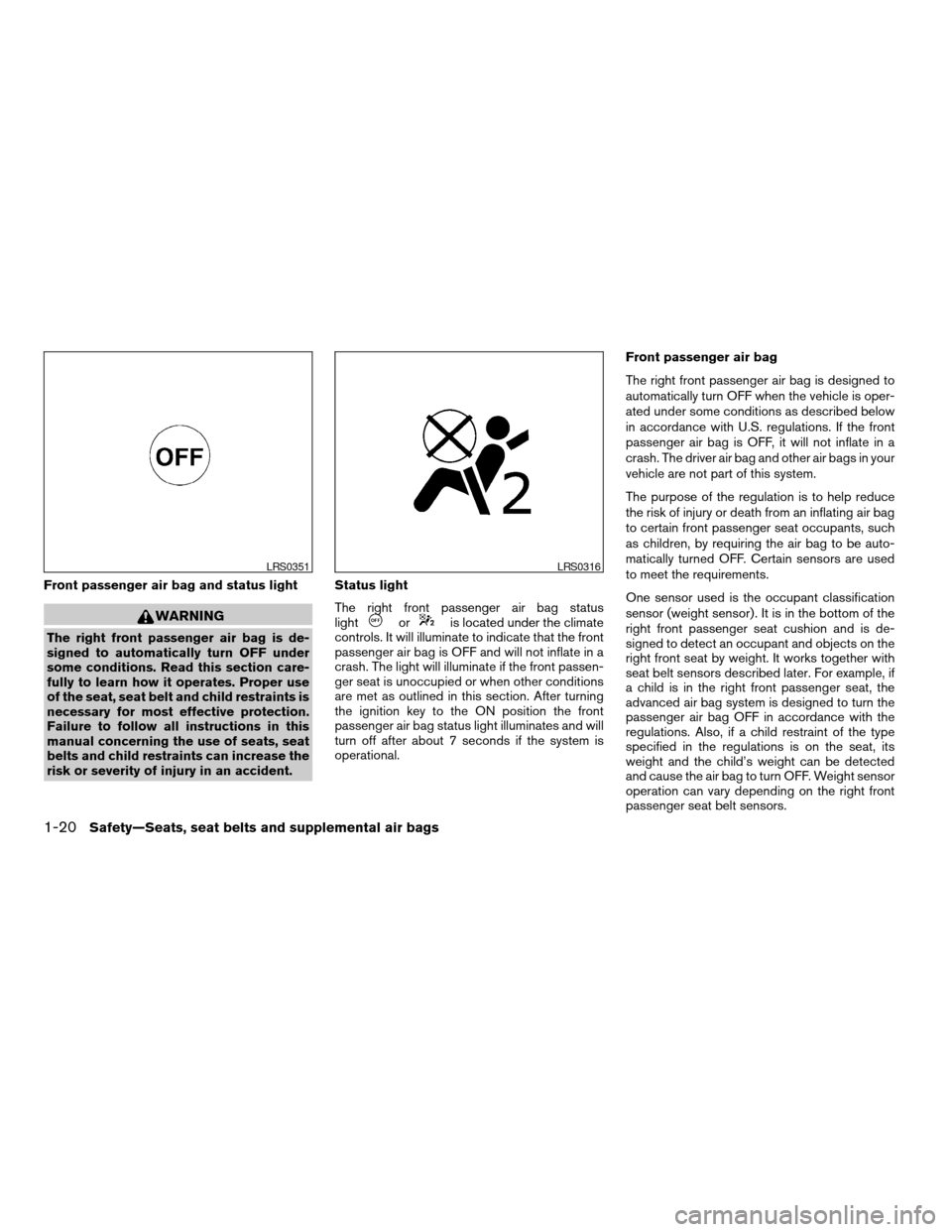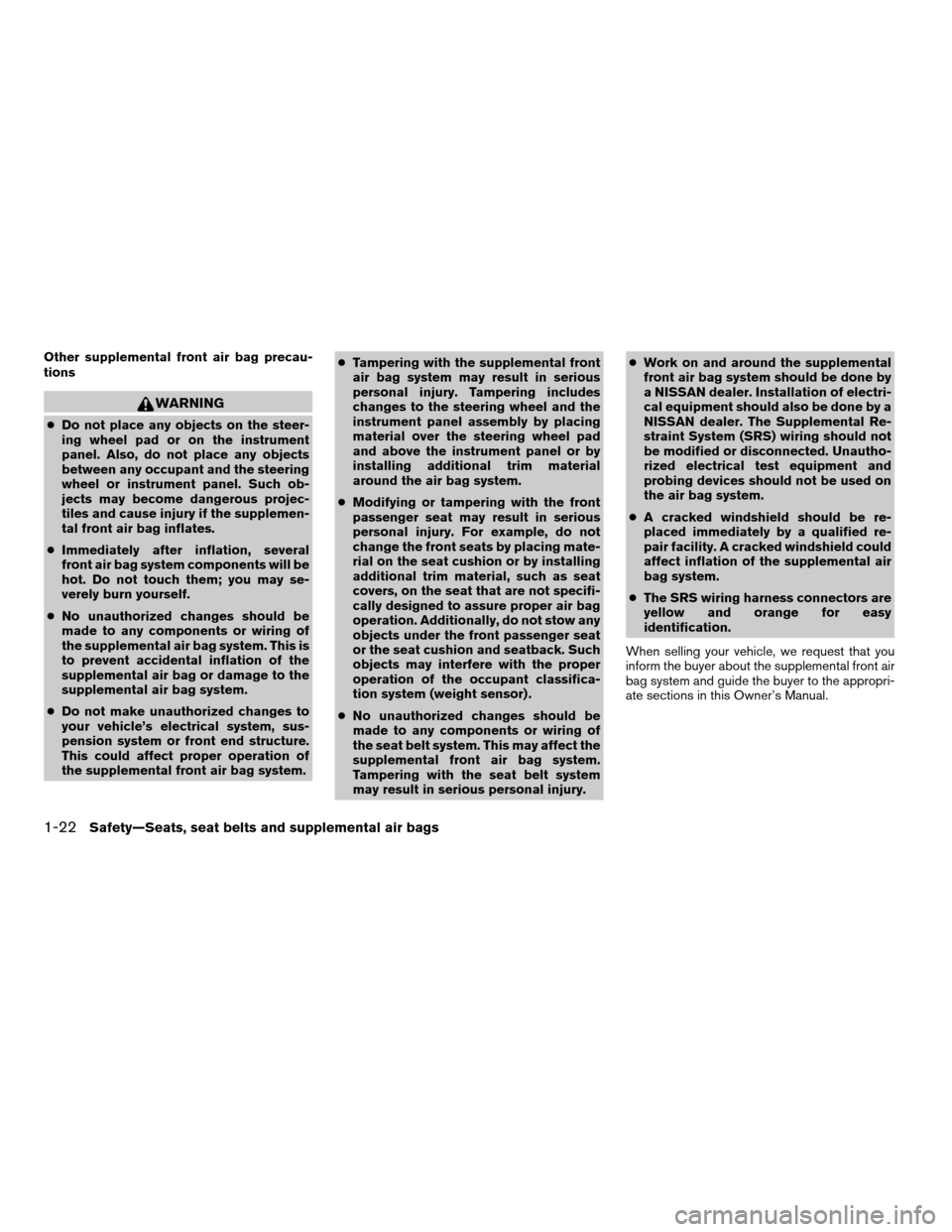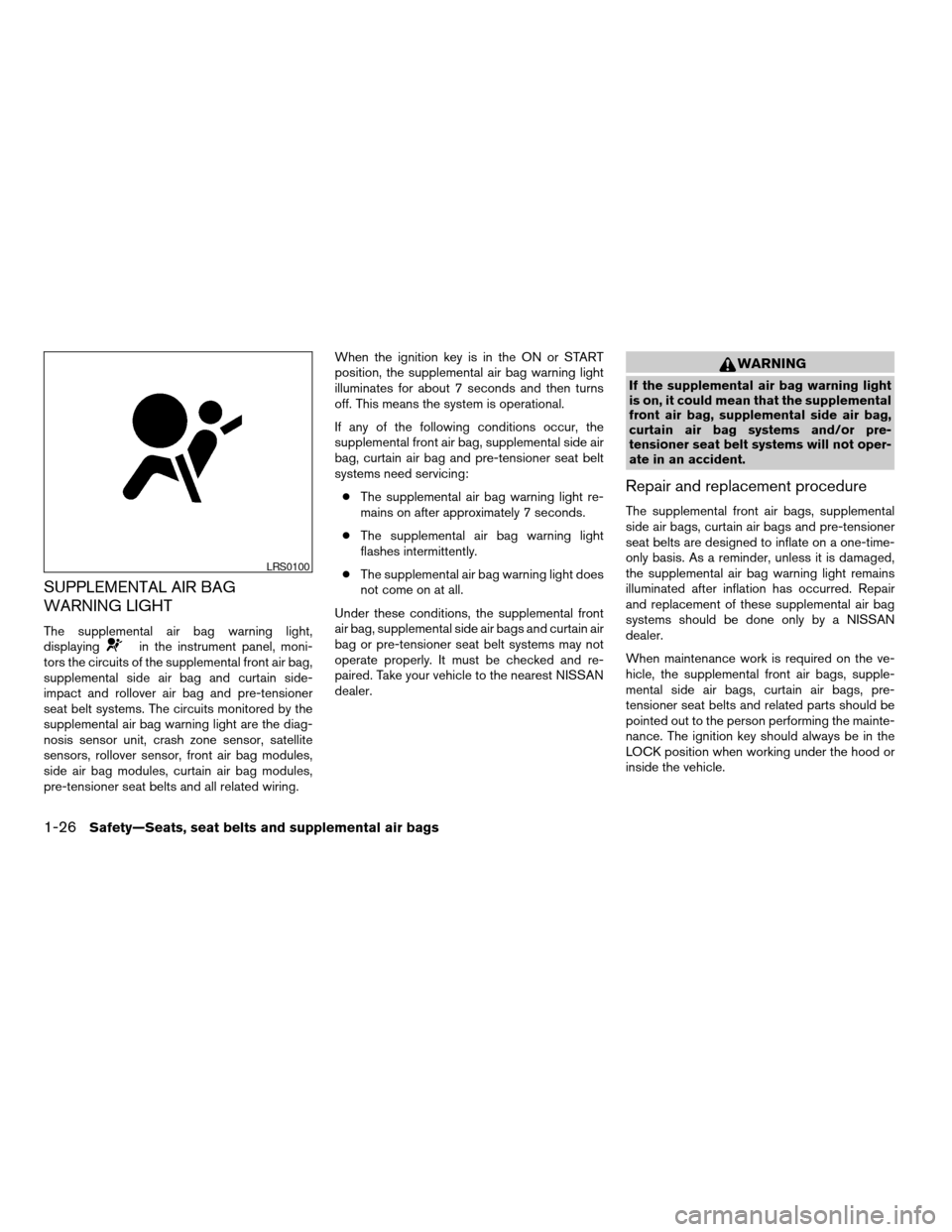2004 NISSAN TITAN sensor
[x] Cancel search: sensorPage 8 of 328

1. 2nd row seat belts (P. 1-27)
2. Supplemental curtain side-impact and
rollover air bags (P. 1-11)
3. Front seat belts (P. 1-27)
4. Supplemental front impact air bags
(P. 1-11)
5. Seats (P. 1-2)
6. Occupant classification sensor (weight
sensor) (P. 1-20)
7. Seat belt pretensioners (P. 1-24)
8. Supplemental side impact air bag
(if so equipped) (P. 1-11)
9. LATCH (Lower Anchors and Tethers for
CHildren) (P. 1-43)
10. Top tether strap anchor point (P. 1-45)
See the page number indicated in paren-
theses for operating details.
LII0028
AIRBAGS, SEAT BELTS AND CHILD
RESTRAINTS
0-2Illustrated table of contents
ZREVIEW COPY:Ð2004 Titan(tzw)
Owners Manual(owners)ÐUSA English(nna)
02/20/04Ðtbrooks
X
Page 28 of 328

WARNING
cThe supplemental front air bags ordi-
narily will not inflate in the event of a
side impact, rear impact, rollover, or
lower severity frontal collision. Also,
the right front passenger air bag will not
inflate if the passenger air bag status
light is lit. See “Front passenger air bag
and status light” later in this section.
Always wear your seat belts to help
reduce the risk or severity of injury in
various kinds of accidents.c
The seat belts and the supplemental front
air bags are most effective when you are
sitting well back and upright in the seat.
The front air bags inflate with great force.
Even with the NISSAN advanced air bag
system, if you are unrestrained, leaning
forward, sitting sideways or out of posi-
tion in any way, you are at greater risk of
injury or death in a crash. You may also
receive serious or fatal injuries from the
supplemental front air bag if you are up
against it when it inflates. Always sit back
against the seatback and as far away as
practical from the steering wheel or in-
strument panel. Always use the seat belts.
cThe driver and right front passenger
seat belt buckles are equipped with
sensors that detect if the seat belts are
fastened. The advanced air bag system
monitors the severity of a collision and
seat belt usage then inflates the air
bags. Failure to properly wear seat
belts can increase the risk or severity of
injury in an accident.
cThe right front passenger seat is
equipped with an occupant classifica-
tion sensor (weight sensor) that turns
the right front passenger air bag OFF
under some conditions. This sensor is
only used in this seat. Failure to be
properly seated and wearing the seat
belt can increase the risk or severity of
injury in an accident. See “Front Pas-
senger air bag and status light” later in
this section.
cKeep hands on the outside of the steer-
ing wheel. Placing them inside the
steering wheel rim could increase the
risk that they are injured when the
supplemental front air bag inflates.
WRS0031
1-12Safety—Seats, seat belts and supplemental air bags
ZREVIEW COPY:Ð2004 Titan(tzw)
Owners Manual(owners)ÐUSA English(nna)
02/20/04Ðtbrooks
X
Page 34 of 328

1. SRS curtain side-impact and rollover air
bag modules
2. SRS curtain side-impact and rollover air
bag
3. Diagnosis sensor unit
4. Supplemental front air bag modules
5. Crash zone sensor
6. Occupant classification system control
unit
7. Occupant classification sensor
8. Seat belt buckle switches
9. Pre-tensioner retractor
10. Satellite sensors
11. Supplemental side air bag modules (if
so equipped)
NISSAN Advanced Air Bag System
(front seats)
This vehicle is equipped with the NISSAN ad-
vanced air bag system for the driver and right
front passenger seats. This system is designed to
meet certification requirements under U.S. regu-
lations. It is also permitted in Canada.However,
all of the information, cautions and warn-
ings in this manual still apply and must be
followed.
The driver supplemental front air bag is located in
the center of the steering wheel. The passenger
WRS0405
1-18Safety—Seats, seat belts and supplemental air bags
ZREVIEW COPY:Ð2004 Titan(tzw)
Owners Manual(owners)ÐUSA English(nna)
02/20/04Ðtbrooks
X
Page 35 of 328

supplemental front air bag is mounted in the
dashboard above the glove box. The supplemen-
tal front air bags are designed to inflate in higher
severity frontal collisions, although they may in-
flate if the forces in another type of collision are
similar to those of a higher severity frontal impact.
They may not inflate in certain frontal collisions.
Vehicle damage (or lack of it) is not always an
indication of proper supplemental front air bag
system operation.
The NISSAN advanced air bag system has dual
stage inflators. It also monitors information from
the crash zone sensor, the diagnosis sensor unit,
seat belt buckle sensors, occupant classification
sensor (weight sensor) and right front passenger
seat belt tension sensor. Inflator operation is
based on the severity of a collision and seat belt
usage for the driver. For the right front passenger,
it additionally monitors the weight of an occupant
or object on the seat and seat belt tension. Based
on information from the sensors, only one front air
bag may inflate in a crash, depending on the
crash severity and whether the front occupants
are belted or unbelted. Additionally, the front
passenger air bag may be automatically turned
OFF under some conditions, depending on the
weight detected on the passenger seat and how
the seat belt is used. If the front passenger air bag
is OFF, the passenger air bag status light will be
illuminated. See “Front passenger air bag andstatus light” later in this section for further details.
One front air bag inflating does not indicate im-
proper performance of the system.
If you have any questions about your air bag
system, please contact NISSAN or your NISSAN
dealer. If you are considering modification of your
vehicle due to a disability, you may also contact
NISSAN. Contact information is contained in the
beginning of this Owner’s Manual.
When a supplemental front air bag inflates, a
fairly loud noise may be heard, followed by the
release of smoke. This smoke is not harmful and
does not indicate a fire. Care should be taken to
not inhale it, as it may cause irritation and chok-
ing. Those with a history of a breathing condition
should get fresh air promptly.
Supplemental front air bags, along with the use of
seat belts, help to cushion the impact force on
the face and chest of the driver and right front
passenger. They can help save lives and reduce
serious injuries. However, an inflating front air
bag may cause facial abrasions or other injuries.
Front air bags do not provide restraint to the
lower body.
Even with NISSAN advanced air bags, seat belts
should be correctly worn and the driver and pas-
senger seated upright as far as practical away
from the steering wheel or instrument panel. The
supplemental front air bags inflate quickly in orderto help protect the front occupants. Because of
this, the force of the front air bag inflating can
increase the risk of injury if the occupant is too
close to, or is against, the front air bag module
during inflation.
The front air bags deflate quickly after a collision.
The supplemental front air bags operate
only when the ignition switch is in the ON
or START position.
After turning the ignition key to the ON
position, the supplemental air bag warning
light illuminates. The supplemental air bag
warning light will turn off after about 7
seconds if the system is operational.
Safety—Seats, seat belts and supplemental air bags1-19
ZREVIEW COPY:Ð2004 Titan(tzw)
Owners Manual(owners)ÐUSA English(nna)
02/20/04Ðtbrooks
X
Page 36 of 328

Front passenger air bag and status light
WARNING
The right front passenger air bag is de-
signed to automatically turn OFF under
some conditions. Read this section care-
fully to learn how it operates. Proper use
of the seat, seat belt and child restraints is
necessary for most effective protection.
Failure to follow all instructions in this
manual concerning the use of seats, seat
belts and child restraints can increase the
risk or severity of injury in an accident.Status light
The right front passenger air bag status
lightoris located under the climate
controls. It will illuminate to indicate that the front
passenger air bag is OFF and will not inflate in a
crash. The light will illuminate if the front passen-
ger seat is unoccupied or when other conditions
are met as outlined in this section. After turning
the ignition key to the ON position the front
passenger air bag status light illuminates and will
turn off after about 7 seconds if the system is
operational.Front passenger air bag
The right front passenger air bag is designed to
automatically turn OFF when the vehicle is oper-
ated under some conditions as described below
in accordance with U.S. regulations. If the front
passenger air bag is OFF, it will not inflate in a
crash. The driver air bag and other air bags in your
vehicle are not part of this system.
The purpose of the regulation is to help reduce
the risk of injury or death from an inflating air bag
to certain front passenger seat occupants, such
as children, by requiring the air bag to be auto-
matically turned OFF. Certain sensors are used
to meet the requirements.
One sensor used is the occupant classification
sensor (weight sensor) . It is in the bottom of the
right front passenger seat cushion and is de-
signed to detect an occupant and objects on the
right front seat by weight. It works together with
seat belt sensors described later. For example, if
a child is in the right front passenger seat, the
advanced air bag system is designed to turn the
passenger air bag OFF in accordance with the
regulations. Also, if a child restraint of the type
specified in the regulations is on the seat, its
weight and the child’s weight can be detected
and cause the air bag to turn OFF. Weight sensor
operation can vary depending on the right front
passenger seat belt sensors.
LRS0351LRS0316
1-20Safety—Seats, seat belts and supplemental air bags
ZREVIEW COPY:Ð2004 Titan(tzw)
Owners Manual(owners)ÐUSA English(nna)
02/20/04Ðtbrooks
X
Page 37 of 328

The right front passenger seat belt sensors are
designed to detect if the seat belt is buckled and
the amount of tension on the seat belt, such as
when it is in the automatic locking mode (child
restraint mode) . Based on the weight on the seat
detected by the weight sensor and the belt ten-
sion detected on the seat belt, the advanced air
bag system determines whether the front pas-
senger air bag should be automatically turned
OFF as required by the regulations.
Right front passenger seat adult occupants who
are properly seated and using the seat belt as
outlined in this manual should not cause the
passenger air bag to be automatically turned
OFF. For small adults it may be turned OFF. Also,
if the occupant takes his/her weight off the seat
cushion (for example, by not sitting upright, by
sitting on an edge of the seat, or by otherwise
being out of position) , this could cause the sen-
sor to turn the air bag OFF. In addition, if the
occupant improperly uses the right front seat belt
in the automatic locking mode (child restraint
mode) , this could cause the air bag to be turned
OFF. Always be sure to be seated and wearing
the seat belt properly for the most effective pro-
tection by the seat belt and supplemental air bag.
NISSAN recommends that pre-teens and chil-
dren be properly restrained in a rear seat.
NISSAN also recommends that appropriate child
restraints and booster seats be properly installedin a rear seat. If this is not possible, the weight
sensor and seat belt sensors are designed to
operate as described above to turn the front
passenger air bag OFF for specified child re-
straints as required by the regulations. Failing to
properly secure child restraints and to use the
automatic locking mode (child restraint mode)
may allow the restraint to tip or move in an acci-
dent or sudden stop. This can also result in the
passenger air bag inflating in a crash instead of
being OFF. See “Child restraints” later in this
section for proper use and installation.
If the right front passenger seat is not occupied
and the seat belt is not buckled, the passenger air
bag is designed not to inflate in a crash. However,
heavy objects placed on the seat could result in
air bag inflation, because of the object’s weight
detected by the weight sensor. Other conditions
could also result in air bag inflation, such as if a
child is standing on the seat, or if two children are
on the seat, contrary to the instructions in this
manual. Always be sure that you and all vehicle
occupants are seated and restrained properly.
Using the passenger air bag status light, you can
monitor when the front passenger air bag is au-
tomatically turned OFF. The light will illuminate
(indicating the air bag is OFF and will not inflate)
when the right front passenger seat is not occu-
pied.If an adult occupant is in the right front seat and
the passenger air bag status light is illuminated
(indicating that the air bag is OFF) , it could be
that the person is a small adult, or is not sitting on
the seat or using the right front seat belt properly.
If a child restraint must be used in the right front
seat, but the status light is not lit (indicating that
the air bag might inflate in a crash) , it could be
that the child restraint or seat belt is not being
used properly. If such situations happen, properly
position and restrain the occupant or child re-
straint. Otherwise reposition the occupant or
child restraint in a rear seat.
If a malfunction occurs in the front passenger air
bag system, the passenger air bag status
light
or, located under the climate
controls, will illuminate and the supplemental air
bag warning light
, located in the meter and
gauges area in the center of the instrument panel,
will blink. Have the system checked by a NISSAN
dealer.
Safety—Seats, seat belts and supplemental air bags1-21
ZREVIEW COPY:Ð2004 Titan(tzw)
Owners Manual(owners)ÐUSA English(nna)
02/20/04Ðtbrooks
X
Page 38 of 328

Other supplemental front air bag precau-
tions
WARNING
cDo not place any objects on the steer-
ing wheel pad or on the instrument
panel. Also, do not place any objects
between any occupant and the steering
wheel or instrument panel. Such ob-
jects may become dangerous projec-
tiles and cause injury if the supplemen-
tal front air bag inflates.
cImmediately after inflation, several
front air bag system components will be
hot. Do not touch them; you may se-
verely burn yourself.
cNo unauthorized changes should be
made to any components or wiring of
the supplemental air bag system. This is
to prevent accidental inflation of the
supplemental air bag or damage to the
supplemental air bag system.
cDo not make unauthorized changes to
your vehicle’s electrical system, sus-
pension system or front end structure.
This could affect proper operation of
the supplemental front air bag system.cTampering with the supplemental front
air bag system may result in serious
personal injury. Tampering includes
changes to the steering wheel and the
instrument panel assembly by placing
material over the steering wheel pad
and above the instrument panel or by
installing additional trim material
around the air bag system.
cModifying or tampering with the front
passenger seat may result in serious
personal injury. For example, do not
change the front seats by placing mate-
rial on the seat cushion or by installing
additional trim material, such as seat
covers, on the seat that are not specifi-
cally designed to assure proper air bag
operation. Additionally, do not stow any
objects under the front passenger seat
or the seat cushion and seatback. Such
objects may interfere with the proper
operation of the occupant classifica-
tion system (weight sensor) .
cNo unauthorized changes should be
made to any components or wiring of
the seat belt system. This may affect the
supplemental front air bag system.
Tampering with the seat belt system
may result in serious personal injury.cWork on and around the supplemental
front air bag system should be done by
a NISSAN dealer. Installation of electri-
cal equipment should also be done by a
NISSAN dealer. The Supplemental Re-
straint System (SRS) wiring should not
be modified or disconnected. Unautho-
rized electrical test equipment and
probing devices should not be used on
the air bag system.
cA cracked windshield should be re-
placed immediately by a qualified re-
pair facility. A cracked windshield could
affect inflation of the supplemental air
bag system.
cThe SRS wiring harness connectors are
yellow and orange for easy
identification.
When selling your vehicle, we request that you
inform the buyer about the supplemental front air
bag system and guide the buyer to the appropri-
ate sections in this Owner’s Manual.
1-22Safety—Seats, seat belts and supplemental air bags
ZREVIEW COPY:Ð2004 Titan(tzw)
Owners Manual(owners)ÐUSA English(nna)
02/20/04Ðtbrooks
X
Page 42 of 328

SUPPLEMENTAL AIR BAG
WARNING LIGHT
The supplemental air bag warning light,
displayingin the instrument panel, moni-
tors the circuits of the supplemental front air bag,
supplemental side air bag and curtain side-
impact and rollover air bag and pre-tensioner
seat belt systems. The circuits monitored by the
supplemental air bag warning light are the diag-
nosis sensor unit, crash zone sensor, satellite
sensors, rollover sensor, front air bag modules,
side air bag modules, curtain air bag modules,
pre-tensioner seat belts and all related wiring.When the ignition key is in the ON or START
position, the supplemental air bag warning light
illuminates for about 7 seconds and then turns
off. This means the system is operational.
If any of the following conditions occur, the
supplemental front air bag, supplemental side air
bag, curtain air bag and pre-tensioner seat belt
systems need servicing:
cThe supplemental air bag warning light re-
mains on after approximately 7 seconds.
cThe supplemental air bag warning light
flashes intermittently.
cThe supplemental air bag warning light does
not come on at all.
Under these conditions, the supplemental front
air bag, supplemental side air bags and curtain air
bag or pre-tensioner seat belt systems may not
operate properly. It must be checked and re-
paired. Take your vehicle to the nearest NISSAN
dealer.
WARNING
If the supplemental air bag warning light
is on, it could mean that the supplemental
front air bag, supplemental side air bag,
curtain air bag systems and/or pre-
tensioner seat belt systems will not oper-
ate in an accident.
Repair and replacement procedure
The supplemental front air bags, supplemental
side air bags, curtain air bags and pre-tensioner
seat belts are designed to inflate on a one-time-
only basis. As a reminder, unless it is damaged,
the supplemental air bag warning light remains
illuminated after inflation has occurred. Repair
and replacement of these supplemental air bag
systems should be done only by a NISSAN
dealer.
When maintenance work is required on the ve-
hicle, the supplemental front air bags, supple-
mental side air bags, curtain air bags, pre-
tensioner seat belts and related parts should be
pointed out to the person performing the mainte-
nance. The ignition key should always be in the
LOCK position when working under the hood or
inside the vehicle.
LRS0100
1-26Safety—Seats, seat belts and supplemental air bags
ZREVIEW COPY:Ð2004 Titan(tzw)
Owners Manual(owners)ÐUSA English(nna)
02/20/04Ðtbrooks
X